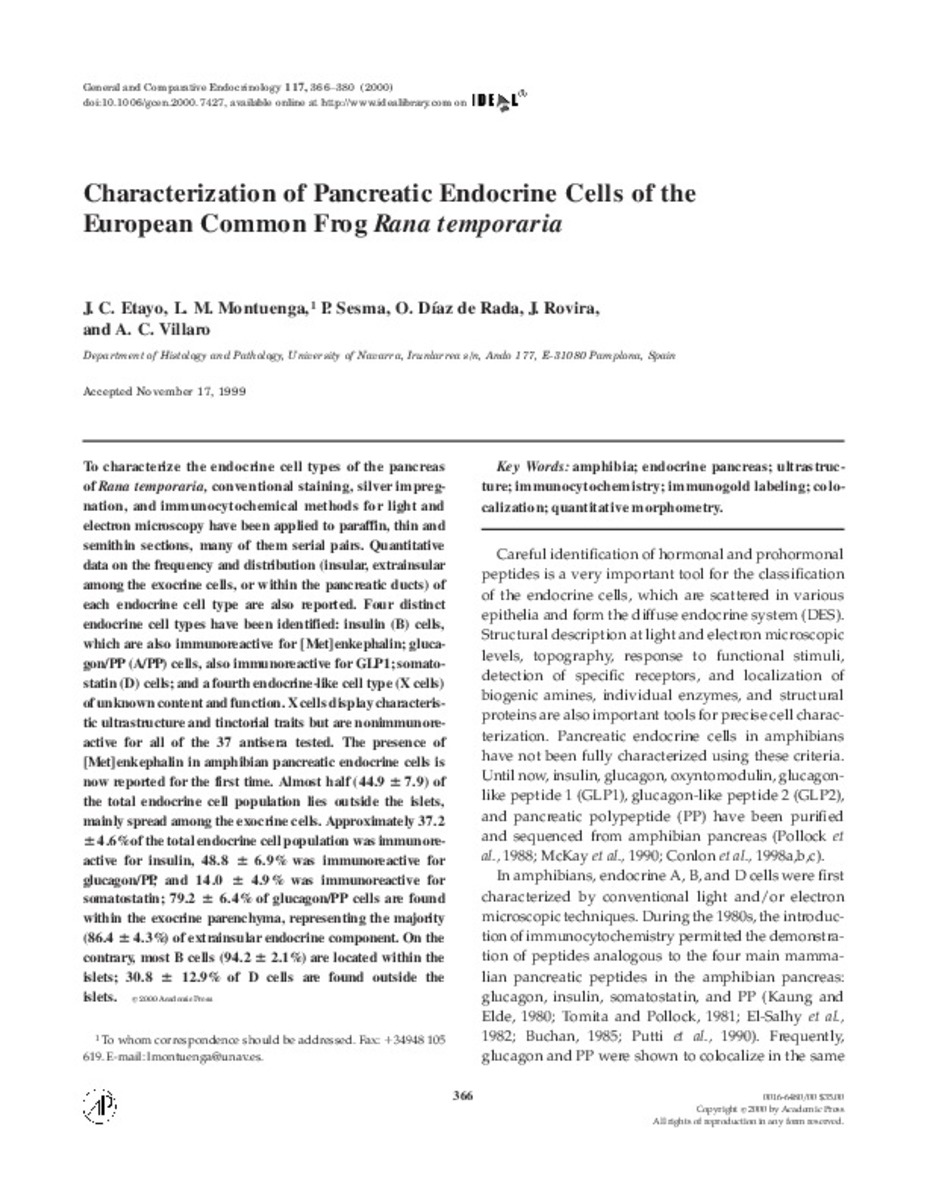Full metadata record
| DC Field | Value | Language |
|---|---|---|
| dc.creator | Etayo, J.C. (Juan Carlos) | - |
| dc.creator | Montuenga-Badia, L.M. (Luis M.) | - |
| dc.creator | Diaz-de-Rada, O. (O.) | - |
| dc.creator | Rovira, J. (J.) | - |
| dc.creator | Villaro, A.C. (Ana Cristina) | - |
| dc.creator | Sesma, M.P. (María Pilar) | - |
| dc.date.accessioned | 2011-12-09T19:08:04Z | - |
| dc.date.available | 2011-12-09T19:08:04Z | - |
| dc.date.issued | 2000 | - |
| dc.identifier.citation | Etayo JC, Montuenga LM, Sesma P, Diaz de Rada O, Rovira J, Villaro AC. Characterization of pancreatic endocrine cells of the European common frog Rana temporaria. Gen Comp Endocrinol 2000 Mar;117(3):366-380. | es_ES |
| dc.identifier.issn | 1095-6840 | - |
| dc.identifier.uri | https://hdl.handle.net/10171/20172 | - |
| dc.description.abstract | To characterize the endocrine cell types of the pancreas of Rana temporaria, conventional staining, silver impregnation, and immunocytochemical methods for light and electron microscopy have been applied to paraffin, thin and semithin sections, many of them serial pairs. Quantitative data on the frequency and distribution (insular, extrainsular among the exocrine cells, or within the pancreatic ducts) of each endocrine cell type are also reported. Four distinct endocrine cell types have been identified: insulin (B) cells, which are also immunoreactive for [Met]enkephalin; glucagon/PP (A/PP) cells, also immunoreactive for GLP1; somatostatin (D) cells; and a fourth endocrine-like cell type (X cells) of unknown content and function. X cells display characteristic ultrastructure and tinctorial traits but are nonimmunoreactive for all of the 37 antisera tested. The presence of [Met]enkephalin in amphibian pancreatic endocrine cells is now reported for the first time. Almost half (44.9 +/- 7.9) of the total endocrine cell population lies outside the islets, mainly spread among the exocrine cells. Approximately 37.2 +/- 4.6% of the total endocrine cell population was immunoreactive for insulin, 48.8 +/- 6.9% was immunoreactive for glucagon/PP, and 14.0 +/- 4.9% was immunoreactive for somatostatin; 79.2 +/- 6.4% of glucagon/PP cells are found within the exocrine parenchyma, representing the majority (86.4 +/- 4.3%) of extrainsular endocrine component. On the contrary, most B cells (94.2 +/- 2.1%) are located within the islets; 30.8 +/- 12.9% of D cells are found outside the islets. | es_ES |
| dc.language.iso | eng | es_ES |
| dc.publisher | Elsevier | es_ES |
| dc.rights | info:eu-repo/semantics/openAccess | es_ES |
| dc.subject | Amphibia | es_ES |
| dc.subject | Endocrine pancreas | es_ES |
| dc.subject | Immunocytochemistry | es_ES |
| dc.subject | Colocalization | es_ES |
| dc.title | Characterization of pancreatic endocrine celCharacterization of pancreatic endocrine cells of the European common frog Rana temporarials of the European common frog Rana temporaria | es_ES |
| dc.type | info:eu-repo/semantics/article | es_ES |
| dc.relation.publisherversion | http://www.sciencedirect.com/science/article/pii/S0016648000974276 | es_ES |
Files in This Item:
Statistics and impact
Items in Dadun are protected by copyright, with all rights reserved, unless otherwise indicated.






